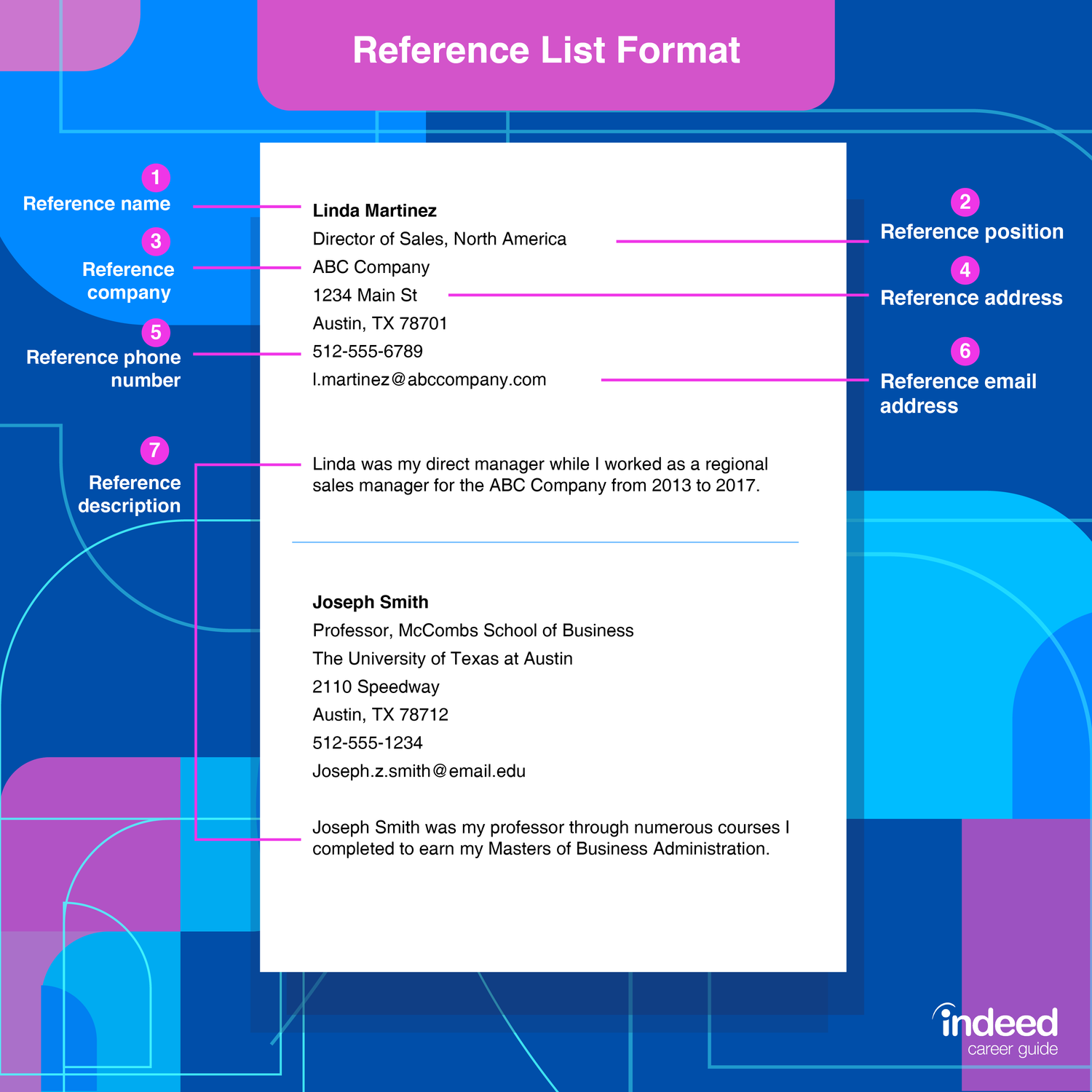How To Create A Reference List For A Job Interview
A resume reference list is a document that provides contact and background information on professional references. Recruiters and hiring managers may contact people on your reference list during the hiring process to learn more about your professional history, job performance and other details about the kind of employee you are.
While some employers may ask you to submit resume references as part of the application process, others may ask after a phone screening, face-to-face interview or before the final step in the hiring process. No matter when an employer asks for references, it's helpful to prepare a list of several reliable contacts who are able to communicate your best professional attributes.

Image description
Reference List Format
- Reference name
- Reference position
- Reference company
- Reference address
- Reference phone number
- Reference email address
- Reference description
Related: How to Email a Resume
How to write a resume reference list
As you begin putting together a list of references for employers to call on during the hiring process, consider the following steps to guide your document.
1. Determine how many references to include
The number of references you list depends on your career level. For example, if you're entering the job market for the first time, you may only need to list three references. However, if you're applying for a more senior role, you will want to consider a longer reference list with contacts from different points in your professional history. Often, employers will provide instruction on how many references they'd like to hear from—in this case, follow any guidance you're given during the hiring process.
Keep in mind that the recruiter may not contact all references on your list. In some cases, they may only call one or two. But having a selection of different types of references ensures they have plenty to choose from if one of your references is unavailable.
2. Select your resume references
When selecting resume references, consider people who can speak to your best qualities, skills and qualifications. If possible, choose people who can discuss talents specific to the job you're applying for.
Generally, the best people to include as references are:
- Current or former manager or direct supervisor
- Current or former co-worker
- Current or former employees/direct reports
- Academic advisor
- Professional mentor
When thinking through who to include on your reference list, make sure you are comfortable with these people knowing you are looking for a new job, especially if they are someone you currently work with.
Related: How to Request a Business Reference
3. Decide how to send your reference list
The only time you should send your reference list with your resume is if the job posting explicitly requests references with the application. Otherwise, wait until a recruiter or hiring manager makes the request. Save space on your resume by removing "references available upon request"—recruiters will request this list if and when they need it during the hiring process. If you're looking for additional guidance while creating your resume, review Indeed's list of resume samples.
4. Ask your contacts to be a reference
It's important you ask your contacts to be a reference before you provide their names. Not only is this a common courtesy, but it also gives them time to prepare for a phone call or email from the employer. Giving your references plenty of notice also ensures they have time to recall specific examples that highlight why you're the best candidate for the role.
Whether you call, email or ask your prospective reference in person, be sure it's something they're comfortable doing. Your best references will be people who enjoyed working with you and are excited to discuss your talents.
Related: How to Include a Referral in Your Cover Letter
Reference list format template
Here is an example of how you can format your resume list. Consider listing your references in chronological order, starting with the person you worked with most recently.

Be sure to include the following information in this order:
Your name
Your phone number
Your email address
Reference name
Reference position
Reference company
Reference company address
Reference phone number
Reference email address
Reference description including where and when you worked together as well as your working relationship.
Related: How to Ask Someone to Be Your Reference: Email Examples
Resume reference list examples
Linda Martinez
Director of Sales, North America
ABC Company
1234 Main St
Austin, TX 78701
512-555-6789
l.martinez@abccompany.com
Linda was my direct manager while I worked as a regional sales manager for the ABC Company from 2013 to 2017.
Joseph Smith
Professor, McCollough School of Business
State University
2000 Speedway
Austin, TX 78712
512-555-1234
joseph.z.smith@email.com
Joseph Smith was my professor through numerous courses I completed to earn my Masters of Business Administration.
Your resume list template should follow the same look and feel as your resume, with the same fonts and colors. This way, if you submit them together, it looks consistent and professional.
After completing the hiring process, be sure to thank your reference for assisting you in your effort to find a new job. Whether it's a quick call, email or a thank you note, it's important you show gratitude to these important connections. After all, their testimonial can go a long way in helping you land an interview and hopefully a new job.
Related: Q&A: Should You Include References on a Resume?
How To Create A Reference List For A Job Interview
Source: https://www.indeed.com/career-advice/resumes-cover-letters/resume-reference-list
Posted by: dickensanyted.blogspot.com

0 Response to "How To Create A Reference List For A Job Interview"
Post a Comment